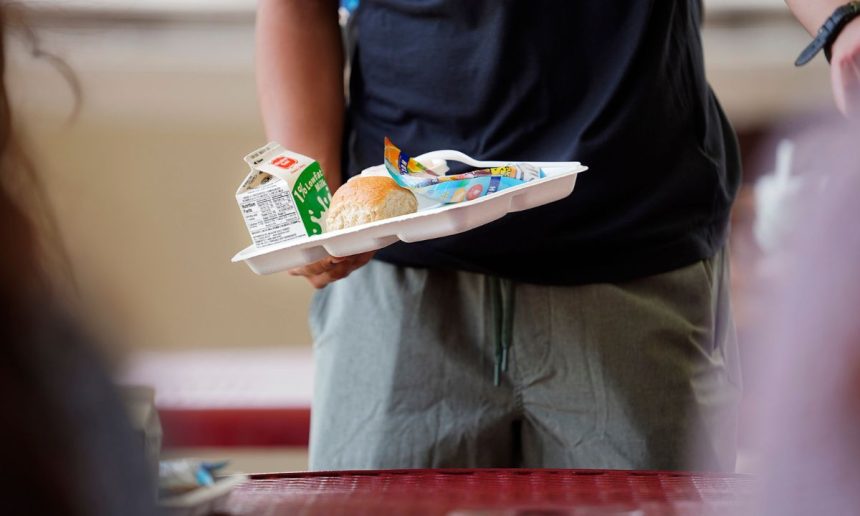This article was originally published in Honolulu Civil Beat.
In January, the Department of Education released a shocking number: it now costs nearly $9 to produce a school lunch in Hawaiʻi. Lawmakers and advocates — after they recovered from the sticker shock — responded with a reasonable question: Why are school meals so expensive?
Eight months later, the public still doesn’t have an answer. Despite pressure from lawmakers, the department has yet to publish detailed information about why it costs so much to feed students.
Get stories like this delivered straight to your inbox. Sign up for The 74 Newsletter
The department doesn’t share — and may not even collect — campus-level data on how much individual schools are spending on meals. It has provided no breakdown of how much the state spends on items like milk or fresh produce that go into lunches.
But lawmakers say schools need to explain what’s driving up the costs, especially since the DOE is struggling to make ends meet with its lunch program and has requested an additional $40 million from the Legislature over the past two years on top of the state and federal funds it already receives for its meal program.
Hawaiʻi law requires the education department to charge families half the cost of producing school meals, although current lunch prices fall far below that threshold. In January, the DOE proposed gradually raising meal prices over the next four years, but state lawmakers stepped in with funds to avoid increasing costs for families.
Under the DOE’s proposal, lunch for elementary and middle school students would cost $4.75 by 2028. High schoolers would pay $5 for meals.
Breaking Down The Numbers
The DOE serves more than 18 million meals every year to students across 258 campuses. This spring, lawmakers set aside roughly $50 million to fund the school meal program over the next two years.
The department publishes quarterly financial reports for its food services branch, but the online reports only track the total amount of money coming in and out of the meals program. Through the third quarterof the 2024-25 school year, the program brought in $108 million in student payments and state and federal funds, but spent roughly $123 million on meals, salaries and other expenses.
In response to a Civil Beat public records request for school and state-level spending on lunches this spring, a representative from the superintendent’s office shared a one-page financial report breaking down the meal program’s spending and revenue in more detail. Roughly 40% of the 2023-24 budget went toward the salaries and benefits of workers, and the department spent roughly $81 million on food.
But there was little information explaining what goes into a $9 school meal — for example, how much the department spent on specific ingredients or juice, or what cafeteria supplies cost the department more than $5.6 million in 2024. The department provides more detailed estimates of its purchase of local ingredients in its annual report to the Legislature, but this spending makes up only 5% of the school meal budget.
In response to Civil Beat’s request, the DOE also said it didn’t have records of schools’ annual financial reports for campus meal programs. The department did not respond to requests for interviews about the availability of school meal data and the rising costs of lunches.
Jesse Cooke, vice president of investments and analytics at Ulupono Initiative, said he’s concerned about a lack of consistent tracking and reporting from schools. He said he hasn’t seen any data breaking down the costs of meal programs at individual schools on a regular basis, which makes it harder for the department and lawmakers to identify what’s driving up the costs of meals and understand how programs can operate more efficiently.
“When you’re trying to make decisions, trying to make something more efficient, you need pretty quick numbers,” Cooke said. “They’re not looking at specific schools and their numbers.”
The education department has also come under fire from the federal government for its lack of data collection. When Hawaiʻi sought an increase in federal funds for school meals in 2015, officials denied the request because the department wasn’t able to provide enough details on the costs of its lunches, said Daniela Spoto, director of food equity at Hawaiʻi Appleseed Center for Law and Economic Justice.
“Historically, the only thing they could provide is what they provided here,” Spoto said. “Here’s our cost, and here’s the total number of meals we provide.”
Lawmakers passed two resolutions this spring asking the department to produce a detailed breakdown of its meal programs, including the cost of ingredients, beverages and supplies. The DOE currently has no process of reporting and publishing such costs, the resolutions stated.
“It is essential to ensure that proper reporting processes are in place to provide transparency as to the costs of producing school meals,” one resolution said.
DOE leaders argued they publish enough information to justify rising lunch costs, but they’ve given lawmakers mixed messages on the data that’s readily available.
In one hearing, Interim School Food Services Branch Administrator Sue Kirchstein said the DOE already collects and publishes data on the costs of ingredients and other factors going into school meals. But another official said the DOE doesn’t collect data with the level of detail lawmakers were requesting, and the department’s communications team was unable to provide the report Kirchstein mentioned during the hearing.
Besides looking at rising inflation rates, the department hadn’t completed a detailed analysis of what’s increasing the costs of meals, former Deputy Superintendent Dean Uchida said in another hearing this spring, drawing strong criticism from lawmakers.
“You should be looking at it, and maybe there’s a different way that you can do things,” Sen. Troy Hashimoto said during the hearing. “But you won’t know that unless you do the analysis.”
The department has not said if it’s working on a cost analysis for the Legislature. Any report DOE submits to lawmakers won’t be published until late 2025 or early 2026 in the lead-up to the new legislative session.









